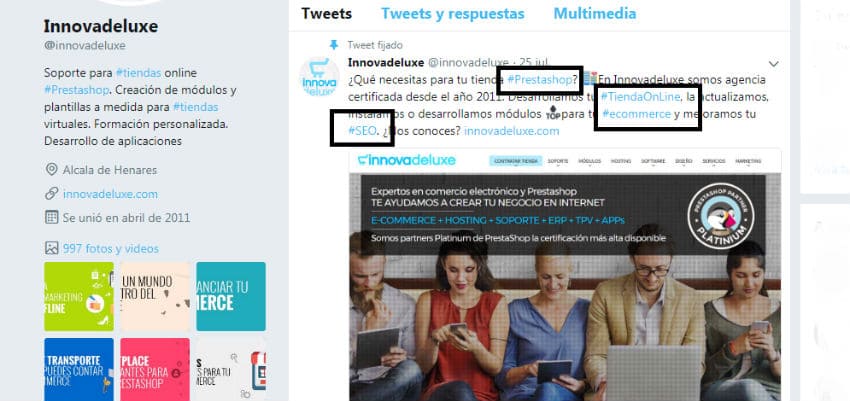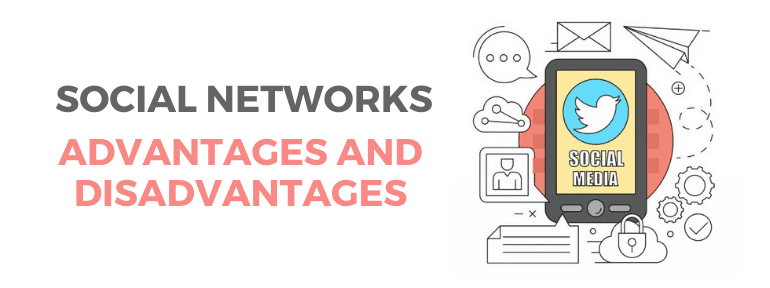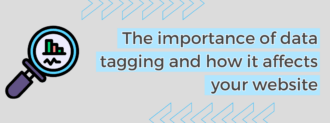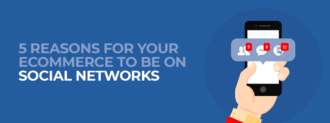Social Networks suffer a paradoxical situation. Many people know them and use them in their free time, from their personal profiles, to tell others about their holidays or upload pictures of their children. But, as a small and medium company (I would like to think that the big ones already have this clear), do you know the advantages and disadvantages of Social Networks for your business or corporation?
Let’s start at the beginning…
Table of contents
- 1 What are the social networks?
- 2 Google Plus for business
- 3 Advantages and disadvantages of social networks for businesses
- 3.1 Advantages and Disadvantages of Twitter
- 3.2 Advantages and disadvantages of corporate Facebook
- 3.3 Advantages and Disadvantages of Instagram
- 3.4 Advantages and disadvantages of Linkedin
- 3.5 Advantages and Disadvantages of Pinterest Business
- 3.6 Advantages and disadvantages of YouTube
- 3.7 Advantages and disadvantages of Google Plus
- 4 Best tools to manage your company’s social networks
- 5 Conclusion
Yes, I’m sure that a priori you’ll tell me that you know what social networks are. Of course you know that there are Twitter and Facebook, but can you tell us the purpose of each one? Or why you should use them as part of a business strategy?

Twitter for business
Twitter is a microblogging social network with more than 300 million users worldwide. When we say microblogging, we mean that it’s about sharing small pieces of content that differentiate you from the competition, accompanying it with a link to your blog post, the landing page of your website, the link to your latest corporate video on YouTube or attaching an infographic or image.
It’s a fast, immediate platform, and therefore, ideal to achieve virality: I mean, that your content is quickly shared or you have many RT and favorites. Twitter is totally open (unless you choose to make your profile private, but as a company, that would make sense) and you don’t need to follow someone or them to follow you to be able to locate people you are interested in and interact with them.
As a business, on Twitter you can share not only your products or business blog content, but photos and notes from industry events you attend, or even the ones you organize.

Facebook for business
Facebook has more than 54 million users in UK alone. Although it emerged as a personal network, it also allows you to create specific pages for businesses, with a lot of features that you can use.
Texts on Facebook can be as long as you want, but that doesn’t mean you should write the bible: they should just be an introduction to the link or image you want to spread.
A trick: if what you want is to spread a video that you’ve created, don’t link it from YouTube, upload it directly to Facebook and you’ll have a greater reach.

Instagram Business for your company
Instagram is part of Facebook, who acquired the platform in 2012, so the two are very interrelated. Instagram is rarely used in desktop, and practically always on the mobile app. Its audience is mostly under 40 years old, and the role of women stands out. So if this is your target, this could be your site.
Its component is totally visual, since the protagonist are mainly the images – or short videos -, and there are companies that make real works of art in the form of compositions. For a company, text is totally secondary, and the shorter the better.
Instagram is an ideal social network to share the most human side of your brand, if that’s what you’re looking for. But also the more commercial side, because since 2017 you have the option to sell your company’s products directly from the platform.
Your company page on Linkedin
Linkedin has been around since 2012, and no, it’s not just a platform to upload your CV and that’s it. It’s also the perfect tool to create a brand image in a truly professional environment.
The vast majority of Linkedin users (8 out of 10) are over 35 years old. In other words, they can and do take responsibility for decision making, which can be very good for your business.
That’s why it’s important that you take advantage of the functionality of your LinkedIn company page, where you can post about your products, achievements, initiatives, etc. Also, Linkedin users search for keywords, just like on Google, so make sure you use the right ones.

Pinterest for business
Pinterest is perhaps the social network that we think about the least when it comes to using it in our business strategy. However, it has over 150 million active users worldwide – that’s quite a lot, if you ask me!
If your target audience is female between 18 and 45 years old, Pinterest can be your network. Although the participation of men is rising, reaching already 40% of users.
Pinterest is highly focused on the visual image but from the point of view of sharing. On Pinterest you can (and should) upload your own pins – a Pin is what each post is called. But it’s also about “pinning” other people’s pins on boards – a Board is like the cork boards you once had in your bedroom or office.
As it could not be less, it also has a Pinterest Business version and has even launched an influencer marketing program.
By now, the fact that every social network has a business version should’ve made it pretty clear to you just how important social media is for businesses.
From Pinterest Business, you can also include photos of products for sale in your company.

YouTube and engagement
The YouTube social network is not just the place to upload music videos or watch all these YouTubers doing crazy things or teaching you through tutorials. YouTube is currently one of the most used search engines, along with Google.
Therefore, if you have a corporate video, or if you are a CEO who wants to give a more personal touch to your company, you can make videos in which you share the latest news of the company, or upload ads for your products, create brand image by doing webinars… There are many options.
You can also create your own YouTube channel, subscribe to channels that interest you, like other videos, and very important, receive comments on your videos, which will allow you to know the opinions or experiences of your customers.
YouTube offers you all these possibilities, and all of them will allow you to get closer to your target audience.

Google Plus for business
Google Plus doesn’t exist any more. It didn’t have much interaction, despiste being a Google tool where you were able to integrate Gmail and use Hangouts as a regular tool for remote meetings.
In the case of Google Plus, there were no “like” buttons, only +1, which was very similar to Facebook likes. But as in Facebook, in Google Plus you were able to publish texts, photos, videos, polls, events and make or participate in communities related to your topic.
It was also possible to follow company or business profiles that interested you, and of course, receive notifications every time someone interacts with you.
If you already have business social networks, here are some tips to revive them
Everything we’ve told you is great, isn’t it? I’m sure that while you’ve been reading, you’ve liked many of the things that have been mentioned But at the same time, you’ve thought that they’re not within your reach.
Indeed, everything has its advantages and disadvantages, and in this case it won’t be less. So let’s take a closer look at the pros and cons of social networks.
The biggest disadvantage is that you can’t be on all the networks at the same time, and do it well. Each network has a different tone and type of content. So you’ll always have to adapt your message and the images that go with it to the specific social network.
So, if you want to do it right, you’re going to have to dedicate time to them, and this translates to:
- Either you have a person who is specifically in charge of managing the company’s social networks.
- Or you use a tool that will facilitate the work (at the end of the post we talk about two in particular)
The first option is the one that probably pushes you back the most, because it involves an economic investment. But in reality, this disadvantage is an advantage. Because this person will not only take care of optimizing the copy (the text you use in each social network) and the corresponding images. But he or she will also be aware of what your audience is saying, looking for them, attending to them, seeing what your competitors are doing, being on the lookout for trends… So in the end, as you can see, in the long run it looks better than it seems.
If you don’t have the option of hiring a Community Manager for your company, here are 5 essential factors to manage social networks even if you don’t have time to do it.

An important advantage is that all social networks have their own statistics, in which you can see what is most liked, has had more interactions, more clicks in the case you put a link, etc. This information will be crucial to improve your business strategy on social networks.
Another not inconsiderable advantage is what is called “social bookmarking“: Google likes content that is shared, and although social networks aren’t a direct factor for Google positioning, the search engine does consider it a sign of quality content. So those contents that are in networks and are shared, make it to a better position in Google.
Continuing with the advantages and disadvantages of social networks, here is one that represents both: in all networks, today, creating ads is as easy as hitting the promote button that appears on each post you publish, and choose the goal of your promotion, which may vary depending on the network: more visits, more traffic or more views.
The disadvantage is that this implies, in turn, an economic outlay. And before you get to that, you’ll have to do a study and see if it’s worth it.
This has been a quick overview of the advantages and disadvantages of social networks in general. But let’s now get down to the pros and cons of social networking, one by one.

Advantages and Disadvantages of Twitter
One advantage of Twitter is that it’s usually the network where it’s easiest to get visibility – the reach is greater than, for example, on Facebook, the other network par excellence. This can be achieved, for instance, by using hashtags to draw attention to certain topics or products
Even if you don’t know what it is by name, you’ve probably seen things like #lastsummer. Well, that’s a hashtag. And another advantage is that you can even create your own for your brand.
A very useful feature of Twitter is the creation of lists by topic. These lists can be public or private, – in case you use them, for example, to follow your direct competitors.
If we move on to the disadvantages of Twitter
- The list functionality helps you to counteract the fact that Twitter is a very fast social network, you’ll miss interesting tweets for sure. But if you have the profiles you are most interested in added to lists, it will be easier not to miss anything.
- Another issue is that at first, many people get confused when they start using it. It’s really easy, but it can be hard to get the hang of it.

Advantages and disadvantages of corporate Facebook
As we said when talking about this social network, when you make your Facebook business page as products and services, one of the advantages is that you have at your fingertips interesting sections to get performance to your business: Add your services, sell your products directly in the Shop tab enabled for it, geolocate your business or collect feedback from your users.
Another advantage is that it’s a good loyalty tool, as it’s a good channel for customer service, as it allows you, when answering your users, to elaborate on the instructions, recommendations, explanations, etc., that you need to convey to them.
You can participate in Facebook groups about your company’s subject, and if you do it constantly and proving that you know what you’re talking about, it has the advantage that you can gain visibility and generate a reputation and brand image.
But now it’s time to talk about two big disadvantages of Facebook:
- It’s marketing with users’ private data, with which it does business by selling it to third parties.
- If the company is just starting out or has few interactions, its publications barely have any reach.
If you want to reach as many people as possible, you’re going to have to pay. The good news is that these are not large amounts. You can promote a post from 2€, for example. It’s a matter of trying it out. And do it only if your content is worth it.

Advantages and Disadvantages of Instagram
Instagram is the counterpart to Facebook and is gaining more and more followers. The advantage is that its reach is greater than that of its “mother” platform and its interactions are much more spontaneous and direct. The content is visual and agile, which is what people are looking for nowadays.
The good thing is that if you create your Instagram Business profile, you’ll connect directly to your Facebook business page, which will allow you to share there what you have published on Instagram.
In a survey of their own users, 60% of people indicated that they had discovered new products thanks to Instagram. And this was in 2015, before the rise of Instagram Shopping, or the boom of Instagram Stories. Both are extremely easy to use tools.
So, what are the disadvantages of Instagram? We’ll leave you with the ones we consider:
- If you want to sell your products, you must have good resolution images of them. And the ideal would be your own images, not ones from stock banks. This means that you have to take them yourself, if you know how to use a camera, or invest in a professional to take the pictures.
- You can’t put links inside the text. They’re copied in plain text and are not clickable. Although you can change them every time you need it in your bio, which is a bit of a hassle. If you do it, always indicate in the publication: “Link in bio”.

Advantages and disadvantages of Linkedin
Let’s start with a great advantage: Hubspot did a study which concluded that Linkedin is twice as effective as Facebook or Twitter to get leads (a lead is a person or company interested in your products and who has left you their contact information)
Needless to say, with these data in hand, that when well used, Linkedin is a good breeding ground for generating business opportunities. That’s why recommending services and content from a company page is a good idea, especially when filtering Linkedin posts by target audience.
You can create up to 10 specific product pages, and fill in up to 20 specialties of what your company does.
Another advantage of Linkedin is that it allows you to share information through groups. You can even create one, if no one else has done so, on a topic in which your company is an expert and you know there is interest. In other words, you can promote your brand.
As disadvantages of Linkedin, we can indicate:
- It’s difficult at first to get interactions if your content is not especially striking or unique.
- However, Linkedin is not a social network to sell. If you only post about what you sell, you’ll soon be known for SPAM.
- As in all networks, you can advertise, but its CPC price is the highest.
- If you are a medium/large company and you really want to take advantage of Linkedin in your marketing strategy, as a company or as CEO, the best option is Premium. Which means 50€ per month.

Advantages and Disadvantages of Pinterest Business
A great advantage of Pinterest is that it ranks very well in search engines, so make sure you use the right descriptions and keywords.
Pinterest is also a very visual social network, but its advantage over Instagram is that you can make boards where you can group images by themes. If you are a decoration e-commerce, you can make a board for the living room, another one for bedrooms, kitchens… Or for separate products like countertops, lamps, etc.
Sharing is as easy as installing the Pinterest extension in your browser and when you see an image that interests you, putting the mouse over it, it will give you directly the option to share. Obviously, you can do this from your own website or online store.
Here’s the next advantage: the pins can include URLs, that is, the link from which the photo or infographic was taken, so they will bring you traffic directly to the website or blog.
This makes clear the potential that Instagram has for your business: if you share an eye-catching and liked product, it will be pinned on many boards, which will give you visibility. You can also make collaborative boards, which allows other users to add pins, which increases interaction and is a way to create community.
This is also important because there are pins from which you can buy, and also promoted pins
If we talk about the disadvantages of Instagram
- We can only think that it’s not the most popular social network for businesses, so before you start using it, you’ll have to see if your target audience is on it.
- If your products and services are suitable to be transmitted through photographs, because not all of them are. You can use Instagram to humanize your brand, but not Pinterest.

Advantages and disadvantages of YouTube
Videos are the content that is most consumed by users. This is already a great advantage that you should take into account and consider whether your company should be on YouTube. From having a corporate video, to creating unique content related to your brand, your products … and always, always, providing value.
Another important factor is imagination and originality when it comes to transmitting your brand message as a company.
Then you would only have to upload the video, with the advantage that YouTube itself has a control panel from which you can easily upload and edit videos, playing with contrasts, putting titles, subtitles, etc…
Let’s see now the disadvantages of YouTube, although there is one that I’m sure you could tell us yourself:
- Not everyone has the knowledge or the tools to create a video. Or the time. There are programs that allow you to create custom videos. But maybe just sitting in front of the camera and explaining your services or products can be enough.
- Be careful about the copyright of the images and music you use. If you’re infringing copyright, YouTube doesn’t mess around and can even close your account.
Advantages and disadvantages of Google Plus
One of the advantages was that if your industry was well represented, you’d had been able to follow and interact with interesting companies. And since it didn’t have as much movement as other networks, the relationship you were able to develop with them could have been closer than in other networks. Just the fact of being there already differentiated you.
But the main advantage that Google Plus had as a social network for businesses was that every link and article you posted on your profile was immediately considered by Google, and would rank better in search engines.
We’re almost done, but as a recap, in this article we tell you things that you shouldn’t do in your company’s social networks.

As we mentioned at the beginning of the post, there are numerous tools that you can use, so that the task of managing social networks doesn’t become so uphill. If you don’t plan to have an unbridled activity, they’ll surely be useful in their free version.
Here are the two tools that we consider the most outstanding.
Metricool
The free version allows you to schedule up to 50 messages per month. It gives you very visual statistics of the interactions achieved. You can even link it to your e-commerce or website and see in real time the visits you’re getting, without having to go log in to Google Analytics.
In addition, based on the activity of your audience, Metricool tells you what are the best times to publish so that your content reaches a bigger audience.
Hootsuite
Not only can you schedule up to 30 messages in the free version, but Hootsuite also allows you to create dashboards where you can see absolutely everything that happens in all the social networks where you have an account. So it’s perfect for monitoring your audience.
As a plus, your free plan also includes a monthly budget of $ 100 for advertising.
Conclusion
As you can see, after analyzing the advantages and disadvantages of social networks, the advantages are many, or so it seems to us.
The most prominent disadvantages can be the investment in advertising and time. But in the long run, the networks can be very useful for our company, so you should still consider having an strategy for them.
Although depending on your sector, to make a real impact, you may need to invest resources and money.
Anyway, remember that the use of social networks in companies does not mean that you should be in all of them, only in those that are more related to your business.
So, are you going to decide, or do you already use them?

Related Posts











Deja un comentario